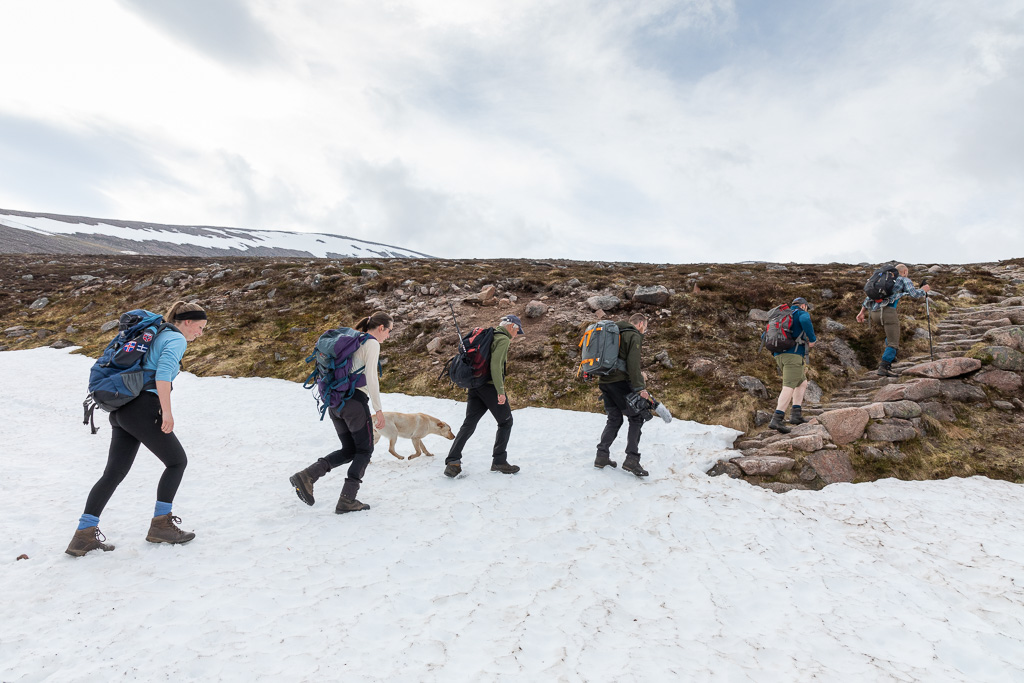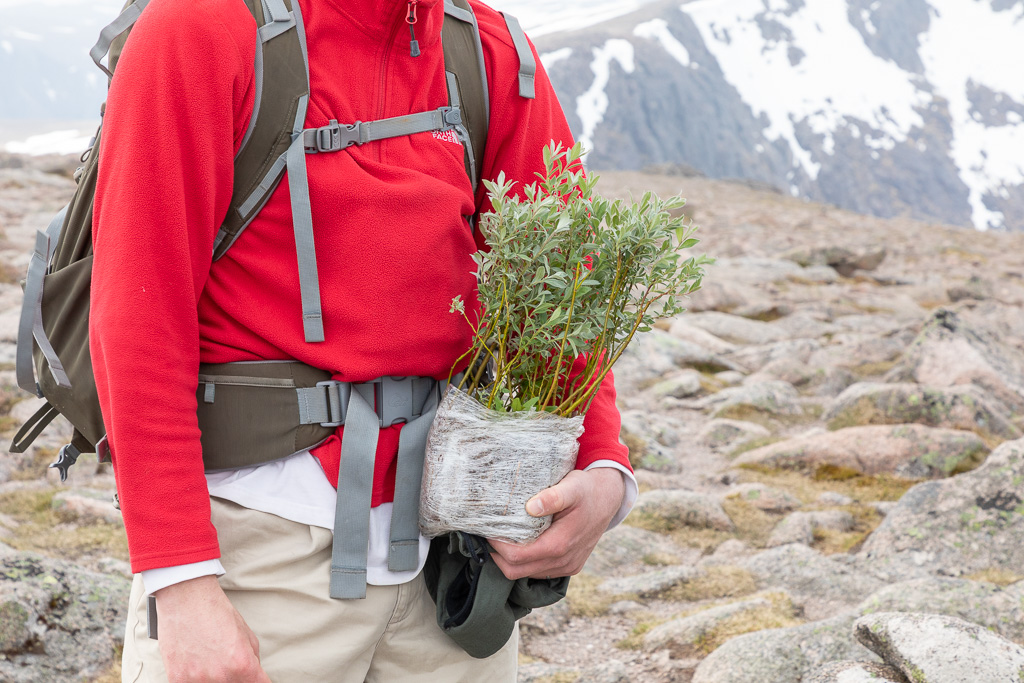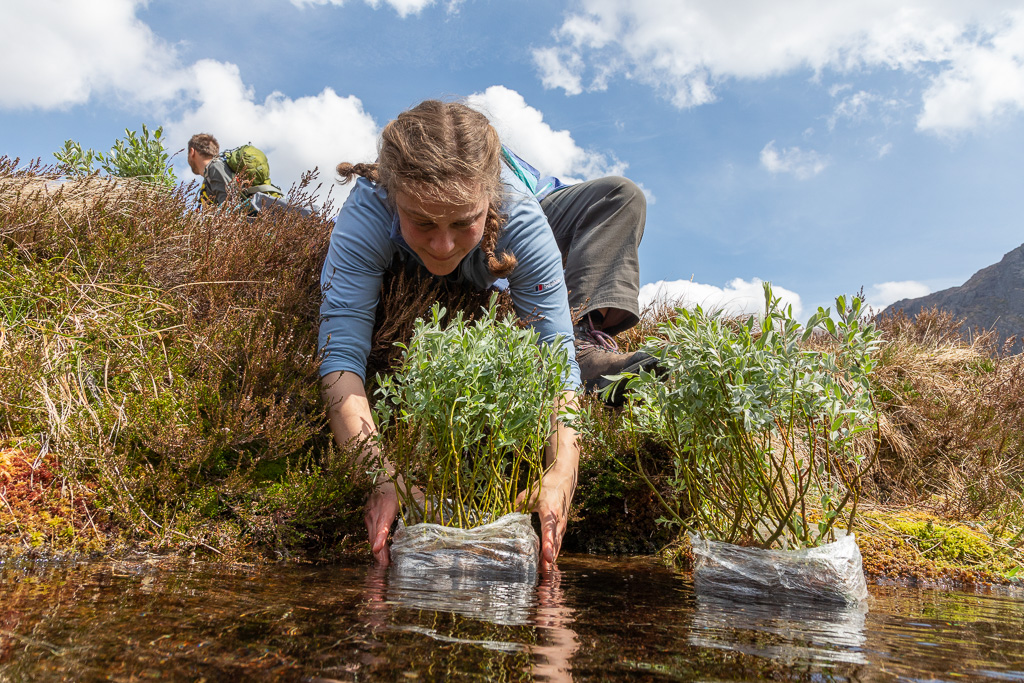

A small species of native willow tree, specially adapted for life in the extreme climate of the Cairngorm mountains, is being thrown a lifeline, thanks to a team effort by local volunteers, Cairngorms Connect, Trees for Life and the Cairngorms National Park Authority.
Earlier this week, a courageous band of Cairngorms Connect partners and local volunteers journeyed up into the Cairngorms with precious cargo; 3,000 saplings of the rare downy willow (Salix lapponum). This small species of native willow tree is specially adapted for life in the extreme climate of the Cairngorm mountains, and the transport and subsequent planting of this hardy shrub is part of a landscape-wide plan to restore native woodlands within the Cairngorms Connect area.

Image (above): A group walk across ice and snow with empty backpacks, ready to be filled with downy willow saplings. Credit: Mark Hamblin.
The downy willow (Salix lapponum) is a member of the willow family, but unlike its more familiar cousins, it only grows to waist height. This extremely rare shrub used to form much of the habitat known as montane scrub and is a reminder that the Cairngorms was once a stronghold of this specialist type of woodland, which occurs high up the mountains in-between the more familiar pine forests and the extreme harshness of the montane plateau. Now only a few scattered downy willow plants remain on cliffs edges and along steep burns, where they are inaccessible to grazing by deer and other animals, but it is hoped this new initiative will soon see the revitalisation of this largely missing habitat to the Cairngorms, and visitors to the high tops will once again be able to experience this rare and fragile habitat
The project to fortify the existing downy willow population began several years ago when scientists mapped every individual downy willow plant clinging on to life across the Cairngorms, in a study funded by the Cairngorms National Park Authority. Whilst researching these willows, the Royal Botanic Garden Edinburgh found that they are still genetically diverse, a probable sign that they are remnants of a much larger and interconnected historic population. However, scientists suggest that any offspring these remaining downy willows have will lose genetic diversity, which will make them increasingly vulnerable to disease, and thus more fragile. To make matters worse for the downy willow, an individual plant is either male or female, meaning one isolated plant on a cliff edge is not able to produce offspring – and even a small group of plants will not be able to reproduce if all the individuals within it are the same sex.
Image (above): Downy willow plants at the Cairngorms Connect tree nursery, RSPB Abernethy. Credit: Sydney Henderson.
To improve the life-chances of this Cairngorm species on-the-edge, cuttings were taken from downy willows across its range and new, genetically diverse plants have been grown in Trees for Life’s tree nursery at Dundreggan. In May 2021, the first saplings were considered strong enough to be planted out into their natural habitat and in a huge team effort, over 30 staff and volunteers carried 3,000 new trees in special back-packs from the Cairngorm mountain car park to sites around Loch A’an on RSPB Scotland’s Abernethy reserve.

Image (above): A volunteer carries the downy willow up into the Cairngorms. Credit: Mark Hamblin
The Mountain Woodland Action Group (MWAG) has advised on the project, as have experts from Norway, where the montane scrub habitat is still largely intact in very similar environmental conditions to the Cairngorms. The seedlings will be sympathetically planted to follow natural features in the landscape which provide the best growing conditions and will supplement already existing remnant clusters and create new genetically diverse clusters. Planting is now being carried out by a specialist planting contractors.

Image (above): On arrival, the precious downy willow saplings had a quick dook in the burn to rewet their roots. Credit: Mark Hamblin
Image (above): One of the precious downy willow saplings, planted in it's natural home above the shores of Loch A'an. Credit: Steve Blow
Main image: Cairngorms Connect partners and volunteers carrying the downy willow plants up into the Cairngorms, to be planted on the slopes above Loch A'an. Credit: Mark Hamblin.
Rosie Beetschen joins a day of Seed Establishment Trials in the beautiful and remote Strath Nethy to learn about how Cairngorms Connect are working to grow and expand our native forests. Listen or read.
Rosie Beetschen reflects on the Cairngorms Connect Community Conference earlier this month, and an amazing year of projects, fieldwork and volunteering